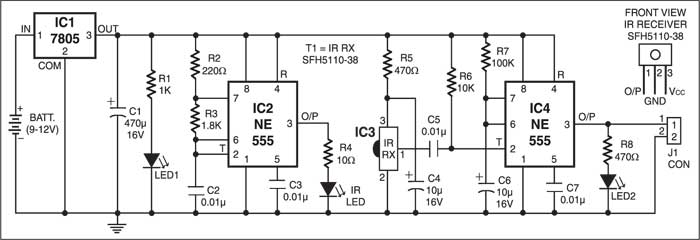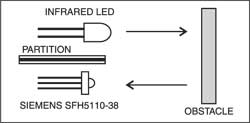 This infrared proximity detector using an infrared detector (Fig. 1) can be used in various equipment like automatic door openers and burglar alarms. The circuit primarily consists of an infrared transmitter and an infrared receiver.
This infrared proximity detector using an infrared detector (Fig. 1) can be used in various equipment like automatic door openers and burglar alarms. The circuit primarily consists of an infrared transmitter and an infrared receiver.
Infrared Proximity Detector Circuit

The transmitter section consists of a 555 timer IC functioning in astable mode. It is wired as shown in the figure. The output from astable is fed to an infrared LED via resistor R4, which limits its operating current. This circuit provides a frequency output of 38 kHz at 50 per cent duty cycle, which is required for the infrared detector/receiver module. Siemens SFH5110-38 is a much better choice than SFH506-38. Siemens SFH5110-38 is turned on by a continuous frequency of 38 kHz with 50 per cent duty cycle, whereas SFH506 requires a burst frequency of 38k to sense. Hence, SFH5110-38 is used.
The receiver section comprises an infrared receiver module, a 555 monostable multivibrator, and an LED indicator. Upon reception of infrared signals, 555 timer (mono) turns on and remains on as long as infrared signals are received. When the signals are interrupted, the mono goes off after a few seconds (period=1.1 R7xC6) depending upon the value of R7-C6 combination. Thus if R7=470 kilo-ohms and C6=4.7µF, the mono period will be around 2.5 seconds.

Both the transmitter and the receiver parts can be mounted on a single breadboard or PCB. The infrared receiver must be placed behind the infrared LED to avoid false indication due to infrared leakage.
Circuit operation
An object moving nearby actually reflects the infrared rays emitted by the infrared LED. The infrared receiver has sensitivity angle (lobe) of 0-60 degrees, hence when the reflected IR ray is sensed, the mono in the receiver part is triggered. The output from the mono may be used in any desired fashion. For example, it can be used to turn on a light when a person comes nearby by energising a relay. The light would automatically turn off after some time as the person moves away and the mono pulse period is over.
The sensitivity of the detector depends on current-limiting resistor R4 in series with the infrared LED. Range is approximately 40 cm. For 20-ohm value of R4 the object at 25 cm can be sensed, while for 30-ohm value of R4 the sensing range reduces by 22.5 cm.
(Note. The author procured the samples of Siemens products from Arihant Electricals, New Delhi, the distributor of Siemens in India.)
This circuit cost around Rs 125 at the time of making. The IR receiver is also available from other manufacturers and can be purchased online.
The article was first published in January 2003 and has recently been updated.







this circuit is not working
Kindly elaborate your query.
How can i get continuous output at receiver side for example an interrupt occurs the receiver must keep on sensing and give output until the interrupt moves out